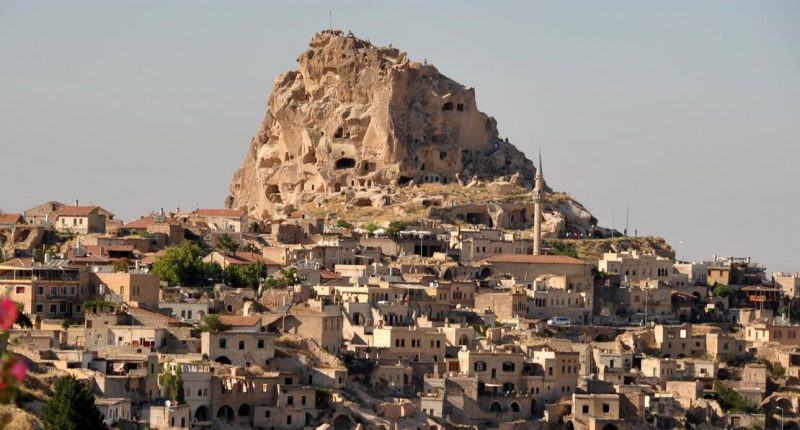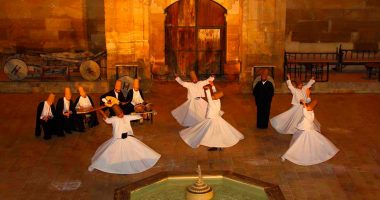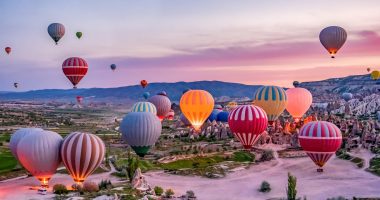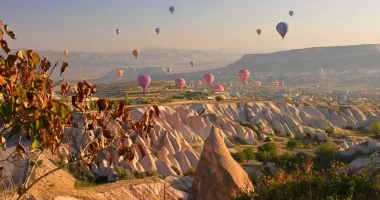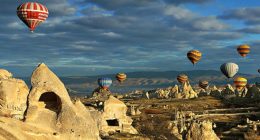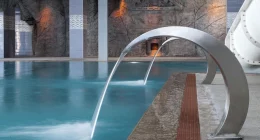Table of Contents
What To See in Cappadocia; In this article, we will give you information about 31 places you should see in Cappadocia. Of course, it is possible to extend this list further. However, we can say that seeing the places on this list will allow you to make a satisfactory Cappadocia trip for you. In order to make your plan more comfortable, we will tell you the places you need to see by separating them according to the districts they are located in.
You may be interested: Cappadocia Underground City
What to See in Göreme?
Love Valley
What To See in Cappadocia; Love Valley is one of the Cappadocia valleys that offers the most beautiful view. It is worth mentioning; You can also hear Love Valley by names such as “Lovers Valley”, “Bağlıdere Valley” or “Lovers Hill”. The reason why this valley is associated with “love” is that it has hosted many marriage proposals until today. You can go up to Lovers Hill at sunset and enjoy the magnificent view.
Love Valley has a pleasant track between vineyards and fruit trees with a length of 4.9 km. You can drive up to a certain place with your vehicle and then walk. The walk in this valley, which is very suitable for nature walks, takes about 2.5 hours.
Goreme Open Air Museum
What To See in Cappadocia; Göreme Open Air Museum, also known as Göreme Ruins, is a fascinating place that is at the top of the list of places to visit in Cappadocia. Göreme Open Air Museum, whose history dates back to the 4th century AD, that is to the first Christian times, is a rock settlement. There are different social areas such as church, chapel, dining hall, school, living room and kitchen in each of the rock blocks in this settlement, which hosted monastic life until the 13th century.
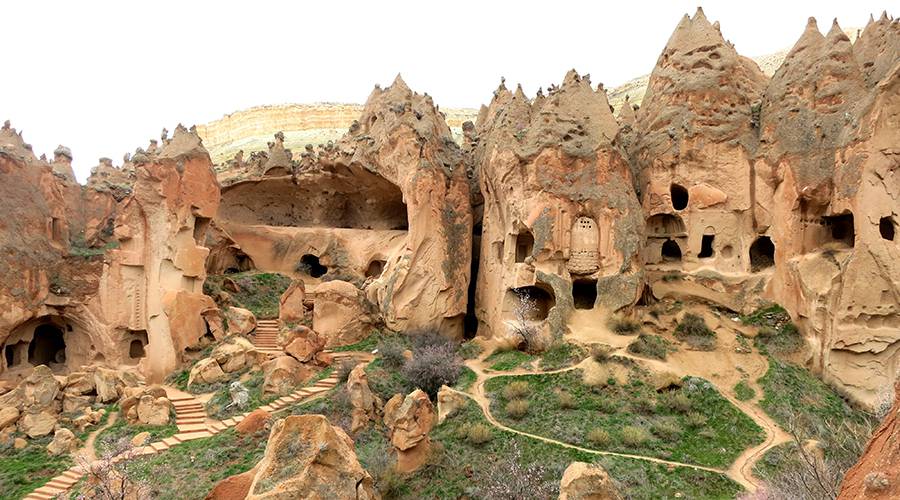
The places to see in Göreme Open Air Museum are as follows:
- Girls and Boys Convent
- St. Basil’s Church
- Apple Church
- St. Barbara Chapel
- Serpentine Church
- Dark Church
- Carikli Church
- Buckled Church
What to See in Urgup?
Hope Hill
What To See in Cappadocia; Temenni Hill is an unmissable rock hill at the center of Ürgüp at an altitude of 80 meters. When viewed from Temenni Hill, which can be seen from anywhere in Ürgüp, a wide area can be seen, including Mount Erciyes. There are also two cupolas and tombs of important people on Temenni Hill, which promises a magnificent view to its visitors.
What To See in Cappadocia; The tomb on the right after entering the hill, namely Kılıçarslan Gazi Tomb, is the place where the story of the name of the hill is hidden. People tie rags to this shrine to make wishes. The cupola in the middle of the hill was used as a public library in the past, but the library was later moved to a new building in the district center. Finally, there are the ruins of St. Georgios Church on the south-west side.
Asmali Mansion
What To See in Cappadocia; Known for “Asmalı Konak”, a TV series that once had a great popularity in Turkey, Asmalı Konak is one of the biggest factors in Ürgüp’s popularity.
Gomeda Valley
What To See in Cappadocia; Gomeda Valley, which is one of the must-see places in Cappadocia, is almost a small part of Ihlara Valley when viewed geomorphologically. For this reason, it is also known as Küçük Ihlara Valley. Gomeda Valley is located in the town of Mustafapaşa, 5 km from Ürgüp.
Although Bey Stream in the valley offers a lively atmosphere with fruit trees and nature, Gomeda Valley is just as scary with its dark caves and rock cavities that look like apartments. There are also many old churches in the Gomeda Valley. Alakara Church, St. Basilios Church are the prominent ones among these churches.
What To See in Cappadocia; However, there is an old underground city in the valley. It is a little difficult to visit the underground city, which has a very small entrance. Because the tunnels and the entrance are quite narrow. After Gomeda Valley, there is Üzengi Valley. Those who love hiking can visit the Üzengi Valley, which has a beautiful hiking trail.
In this article, we will give you information about 31 places you should see in Cappadocia. Of course, it is possible to extend this list further. However, we can say that seeing the places on this list will allow you to make a satisfactory Cappadocia trip for you.
Three Beauties
What To See in Cappadocia; Three Beauties is perhaps the most well-known three fairy chimneys among Cappadocia fairy chimneys. But how did these three fairy chimneys come to the fore when every place is a fairy chimney and every place is a rock formation? First of all, the shapes of these three fairy chimneys are very distinctive. These three fairy chimneys are the ones in which the mushroom hat form that comes to mind when the fairy chimney is mentioned is seen most clearly. For this reason, the Three Beauties have become both the symbol of Cappadocia and the photographic spot for many tourists.
What To See in Cappadocia; There is also a legend of the Three Beauties. According to legend, the daughter of the King of Cappadocia falls in love with a shepherd in the region and wants to get married. Despite the king’s disapproval, the princess and the shepherd get married and have a baby. The king sends soldiers to slaughter the entire family, and all three turn to stone when the princess begins to pray to escape death. It is believed that the foremost fairy chimney of the Three Graces is the shepherd, the middle one is the child and the back one is the princess.
Urgup Museum
What To See in Cappadocia; Ürgüp Museum is a small museum located in the center of Ürgüp. Along with the fossil samples found in and around Ürgüp, the museum also contains finds from the Old Bronze Age, Persian, Roman, Byzantine, etc. periods. Apart from these, there are also ethnographic items belonging to the Ottoman period in the museum.
Mustafapasa
What To See in Cappadocia; Mustafapaşa or Sinasos, as it was known in ancient times, is an old Greek Village located 5 km from Ürgüp. The Turkish population settled in Mustafapaşa, which was a place where Greeks lived until the 1924 Turkish – Greek population exchange. In the town, which used to be about 700 stone mansions, today there are almost 100 houses, nearly 30 churches and chapels.
- The places to see in Mustafapaşa are:
- Mehmet Sakirpasa Madrasa
- St. Nicholas Monastery
- Constantine Helena Church
- Saint Basil’s Church
- St. Basil’s Chapel
- Hidden Valley
- Cappadocia Art and History Museum
- Marasoglu Bridge
- Asmali Mansion
Cappadocia Art and History Museum / Bebek Museum
What To See in Cappadocia; Cappadocia Art and History Museum or Bebek Museum is a museum that can be fun and different even for people who do not like to visit museums in Mustafapaşa. What makes the museum interesting is that the museum mirrors the history of Cappadocia with handmade dolls. The museum, which is Turkey’s first handmade doll museum, has approximately 3,000 dolls and nearly 600 stories.
Today, you can take a look at the history of Cappadocia in the most entertaining way by taking time for the museum, which serves in a mansion with more than 150 years of history.
What to See in Uchisar?
Uchisar Castle
What To See in Cappadocia; The large fairy chimney of Uçhisar Castle, which consists of two combined fairy chimneys, is called Ağa’s Castle, and the smaller one is called Sergeant’s Castle. Uçhisar Castle is also the largest fairy chimney of the region, which can be seen from all over Cappadocia. The summit of the castle is the place where you can see the whole of Cappadocia with a bird’s eye view, and it is the only place where you can see Erciyes Mountain and Hasan Mountain together.
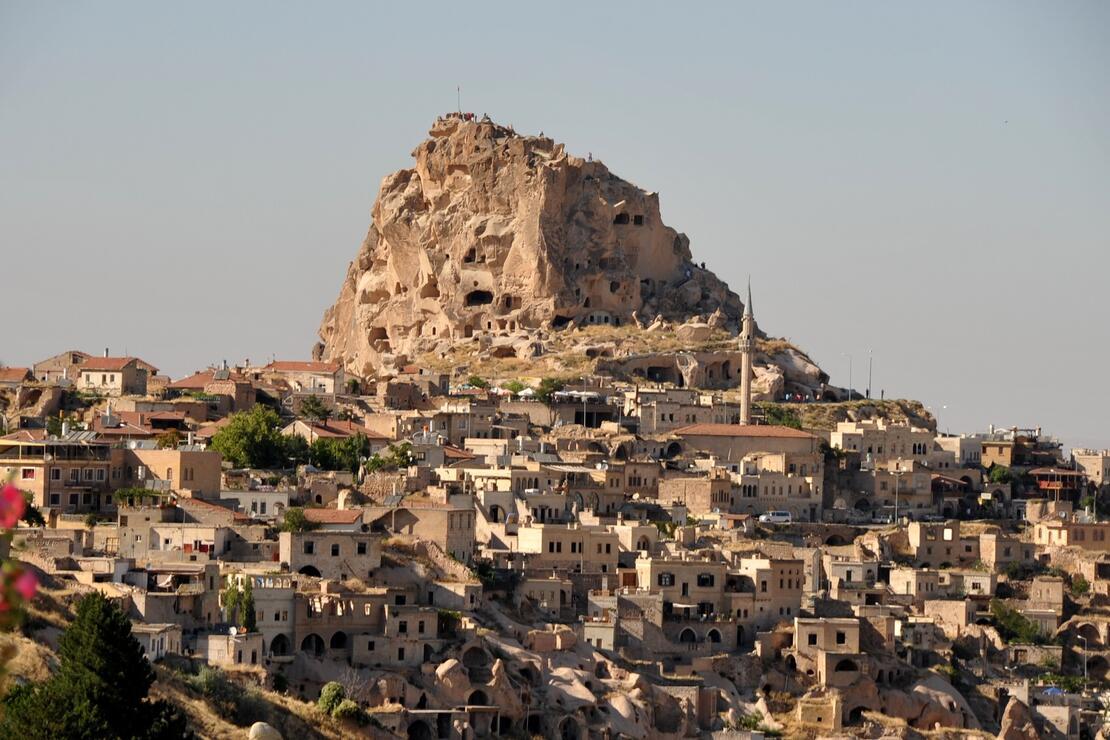
Inside the castle, there are many rooms, tombs, cisterns and shelters carved into the rocks. Especially in Uçhisar Castle, where watching the sunset is incredibly enjoyable, you can encounter an unforgettable view if you come across a day when the balloons take off.
Pigeon Valley
What To See in Cappadocia; Güvercinlik (Pigeon) Valley is one of the most known valleys of Cappadocia with its fairy chimneys and extraordinary rock formations, as well as the most preferred valley for outdoor sports such as trekking, cycling and running. Güvercinlik Valley starts from Uçhisar and continues over an area of 4 km until Göreme.
As the name suggests, the valley has a special relationship with pigeons. The local people who lived here in the past carved pigeon nests in the rocks for pigeons. While feeding the vineyards with the fertilizers they obtained from the birds living in the region, they used the eggs at the angles of the frescoes.
What to See in Ortahisar?
Ortahisar Castle
What To See in Cappadocia; Ortahisar, one of the most well-known towns of Cappadocia, and the famous Ortahisar Castle are one of the places to visit in Cappadocia. Ortahisar Castle is a huge rock formation rising up to 80 meters from the middle of Ortahisar. In addition to the view it has, the castle, with the houses built along its slopes, offers a magnificent view both from below and from above.
Ortahisar Castle, dating from the Hittite period, has been used as a natural shelter throughout history. It is possible to visit the rooms, tunnels and corridors inside the castle.
Ortahisar Ethnography Museum
What To See in Cappadocia; Ortahisar Ethnography Museum is the first ethnography museum of the region where the social life of Cappadocia is animated with mannequins. There are 12 rooms in the museum that deal with and revitalize different subjects. These:
- Building Room
- Chamber of Agriculture
- Turkish bath
- Village Room
- Traditional Cuisine
- Bride’s Room
- Molasses Making Room
- Weaving Room
- Village square
- Marriage Ceremony
- Henna Night
- Ortahisar Souvenir
What to See in Avanos?
Devrent Valley
What To See in Cappadocia; Devrent Valley, also known as Hayal Vadisi or Pink Valley, stands out among the Cappadocia valleys with its more orange-pink rock formations, away from the classical fairy chimney forms. You can compare the fairy chimneys in the valley with many different animals, but the fairy chimneys are most like camels.
Devrent Valley has no specific entrance or exit. It has a U-shaped structure with one end extending to Devrent and the other to Kızılçukur. Compared to other valleys, the hiking trail is also not very suitable.
Avanos Historical Stone Bridge
What To See in Cappadocia; Although the Avanos Stone Bridge, which greets people who come to Avanos, may seem like a standard bridge, you may be happy to know that you are crossing a historical bridge while crossing the bridge. Stones brought from Chech and Karadağ regions around Avanos were used in the construction of the bridge, which was put into service in 1900. The 11-footed bridge has been able to reach today without the need for a serious restoration.
Avanos Suspension Bridge / Wooden Bridge
What To See in Cappadocia; Avanos Suspension Bridge is also known by different names such as “Wooden Bridge”, “Swinging Bridge”. The feature of this bridge is that it sways slightly as you walk on it. This situation is scary for some and quite entertaining for others. The bridge, located over the Kızılırmak, was built in 1973. It is possible to walk comfortably on the bridge as the bridge is only open to pedestrians.
Avanos Hair Museum
What To See in Cappadocia; Also known as Chez Galip Hair Museum after its founder, Galip Körükçü, Avanos Hair Museum is the first of its kind not only in Turkey but also in the world. The museum, which was founded in 1979 and entered the Guinness Book of Records in 1998, contains tufts of hair from more than 16 thousand women. The museum is also on the 6th place in the list of “15 Most Interesting Museums in the World”.
Zelve Open Air Museum
What To See in Cappadocia; Zelve Ruins consists of 3 valleys with the most intense fairy chimneys. This region is also one of the oldest and longest used residential areas of Cappadocia. According to some studies, Christianity first started to spread in the region. It is stated that the Christian settlement started in the valley in the 7th century and the valley became an important religious center between the 9th and 13th centuries.
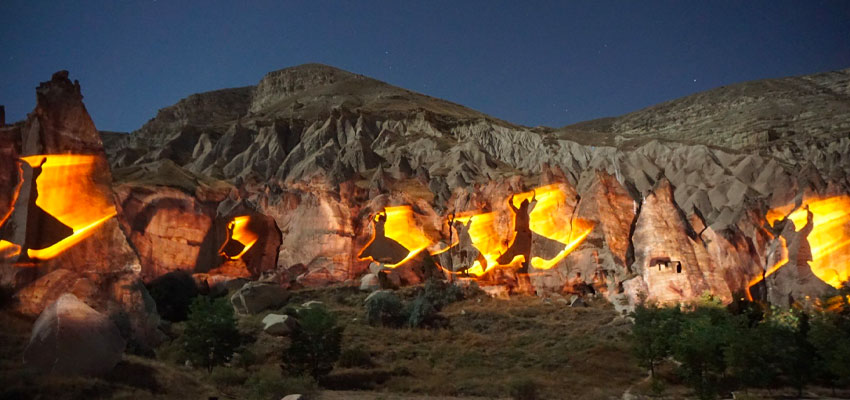
There are monasteries, churches, tunnels, mills and different settlements in the valley where the settlement continued until 1952. The most important points in the valley are 3 churches named Balıklı, Üzümlü (St. Nichitas Church) and Geyikli, which date back to the pre-Iconoclastic period, and a chapel built for St. Simeon.
Sarihan Caravanserai
What To See in Cappadocia; Saruhan Caravanserai, which was built on an area of 2,000 square meters by Izzettin Keykavus in 1249, has a great historical importance as it is the last caravanserai of the Anatolian Seljuk State. Besides, the architecture of the caravanserai is also very interesting. The caravanserai, dominated by 13th century Seljuk architectural features, consists of summer and winter sections.
The most striking part of Sarıhan Caravanserai is its flamboyant gate, known as the Crown Gate form. In addition, the caravanserai, which is impressive in every respect with its seasonal courtyards, rooms, wall decorations and actually its castle-shaped general appearance, serves for cultural and artistic activities and special events under the name “Saruhan Culture and Congress Center”.
Pottery Workshops
What To See in Cappadocia; The Kızılırmak, which runs through the middle of Avanos, one of the most touristic centers of Cappadocia, has not only added visuality to the region but also a completely different culture. Thanks to the pottery made with the ceramic paste obtained by mixing the red soil of Kızılırmak and the spindle, an art unique to Avanos has emerged. This art, which has been going on for years, has now turned into a culture specific to the region and pottery workshops have been opened in Avanos.
These workshops are just perfect places to visit and witness the works of art or to buy a souvenir from Cappadocia. But that doesn’t end there. With the lathe used in making old-style pottery, you can try making your own pottery with the help of masters in many workshops.
Guray Museum
What To See in Cappadocia; Güray Museum is the world’s first and only underground ceramic museum. If you want to explore Avanos ceramics and pottery in more detail and closely, it is one of the museums you should visit. The museum serves with two sections, the “Hall of Ancient Artifacts” and the “Hall of Modern Artifacts”, and a cultural center.
In the Hall of Antiquities, you can see ceramics and pottery works from the Late Chalcolithic Period, Bronze and Iron Ages, Hellenistic, Roman, Byzantine, Seljuk and Ottoman Periods, as well as finds from the region. The Modern Works Hall, on the other hand, features the works of world-famous ceramic artists. Apart from the two halls, there is a cultural center where you can see examples from different branches of art such as photography, painting and sculpture and which hosts different exhibitions.
Cavusin
What To See in Cappadocia; Çavuşin Village, a village in Avanos, stands out as one of the oldest settlements in Cappadocia. Although the village offers a dark atmosphere with ruins on one side, it is actually a very cute residential area. There are many churches in the region where the Christian population lived in the Roman period.
Among these churches, the Çavuşin Church, the Three Crusaders, St. Mary’s Church, Colon Church, and John the Baptist Church are the first to come to mind. Apart from the churches, there are many pottery workshops in Çavuşin Village where you can get to know the pottery tradition closely.
Cavusin Church
What To See in Cappadocia; Perhaps the most prominent church in Cavusin, the region of Cappadocia, which is famous for its churches, is the Cavusin Church. Çavuşin Church is located right at the entrance of the village. The church is located in a rock formation that looks like a castle. The church, which is estimated to date back to 964, is among the oldest churches in Cappadocia. In 1985, it was included in the World Cultural Heritage list, proving its beauty.
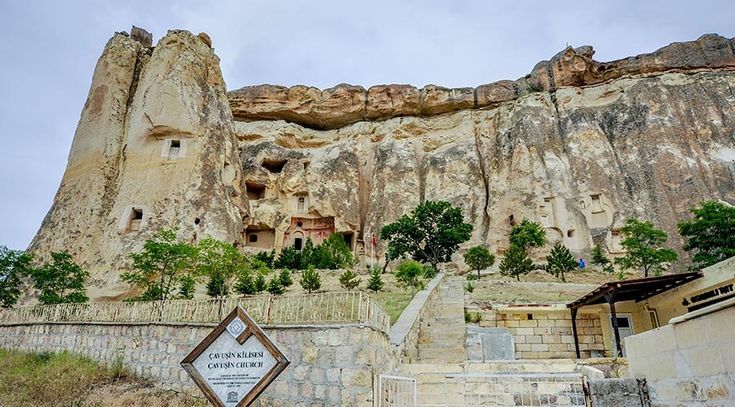
Pasabag Priests Valley
What To See in Cappadocia; The most important feature of Paşabağ Priests Valley is that it hosts the examples that best reflect the formation phase of the fascinating fairy chimney shape. The first thing that comes to mind when talking about fairy chimneys is the figures with mushroom hats.
Another feature of the valley is that it once hosted secluded Christian clergy. For this reason, it is also called the Valley of the Priests and there are also many chapels and churches in the valley. One of the most popular of these is the chapel built in the name of St. Simeon.
Gulludere Valley
What To See in Cappadocia; Güllüdere Valley is a must-visit place for both trekking and landscape lovers. Located between Göreme and Çavuşin, the valley is divided into two branches, Güllüdere I and Güllüdere II, and offers a 4 km trekking route. The fairy chimneys in the valley turn into a red rose color with the sunlight. Especially at sunset, a magnificent view emerges in the valley.
In addition to these, there are churches, monasteries and different living spaces carved into the rocks in the valley.
The churches in Güllüdere Valley are:
- Yovakim – Church of Anna
- Mast Church
- Ayvali Church
- The Crusader Church
- Three Crusaders Church
Kizilcukur Valley
What To See in Cappadocia; One of the most admired places for the sunset view in Cappadocia, perhaps the first, is the Kızılçukur Valley. Kizilcukur Valley is full of red colored tuff rocks unlike the stone colored fairy chimneys. These red rocks turn red at sunset and offer a completely different view with the colors of the sky.
What To See in Cappadocia; Meskendir Valley will greet you after you pass through the tunnels and bumpy roads of the valley, which is a very pleasant walking route in addition to its scenery. It is useful to have a flashlight with you for tunnels and to choose suitable shoes and clothes. During your journey, you can see structures such as churches and monasteries, especially the Cross Church and the Üzümlü Church.
John the Baptist Church
What To See in Cappadocia; The Church of John the Baptist, whose history is estimated to date back to 964 – 965, is one of the oldest churches in Cappadocia. The entrance to the church carved into the rock is followed by a triple basilica dedicated to John the Baptist. The depictions painted on the walls of the church are also very interesting. The walls of Hz. The “Dance of Salome” event, which led to the murder of John the Baptist, who performed the baptism of Jesus, is depicted. At the entrance of the church, you can see the frescoes of Gabriel and Michael.
Cappadocia Underground Cities
Özkonak Underground City
What To See in Cappadocia; Özkonak Underground City, which is estimated to have been built by the Hittites in 400 BC, is located in Özkonak Town, 14 km from Avanos. The underground city, established on the northern slopes of İdiş Mountain, was built into volcanic tuff layers. Built on 4 floors, Özkonak Underground City has stables on the ground floor and living spaces such as rooms, living rooms and baby rooms as you go down to the lower floors. Apart from the rooms, there are also different sections such as wells, tombs and wine warehouses.
The last part of the bottom floor is both frightening and intriguing! The section, which was built as a prison, is accessed through a tunnel where only one person can fit. Özkonak Underground City was built with long and narrow holes that allow communication between floors as a defense strategy. While hiding from the enemy, communication and air exchange were provided through these holes. In addition, holes were drilled into the bolt stones used as doors to prevent the entrance of the enemy, and they were used to throw arrows and spears or pour hot oil.
Thuja Underground City
What To See in Cappadocia; Mazı Underground City, located in Mazı Village, known as Mataza in ancient times, has 8 floors and an estimated capacity of 6,000 people. The underground city has 4 entrances, the main entrance is through a corridor. Inside, there is an ostentatious church as well as different living spaces.
Note: Click for German dream interpretations
Derinkuyu Underground City
What To See in Cappadocia; Derinkuyu Underground City is the best known underground city of Cappadocia. Derinkuyu Underground City, which is 30 km from Nevşehir and has almost 500 underground cities, is located in Derinkuyu district. The history of Derinkuyu Underground City dates back to the Assyrian colonies. There is everything that a large society can sustain in the 8-storey underground city, which is large enough for almost 50,000 people to live.
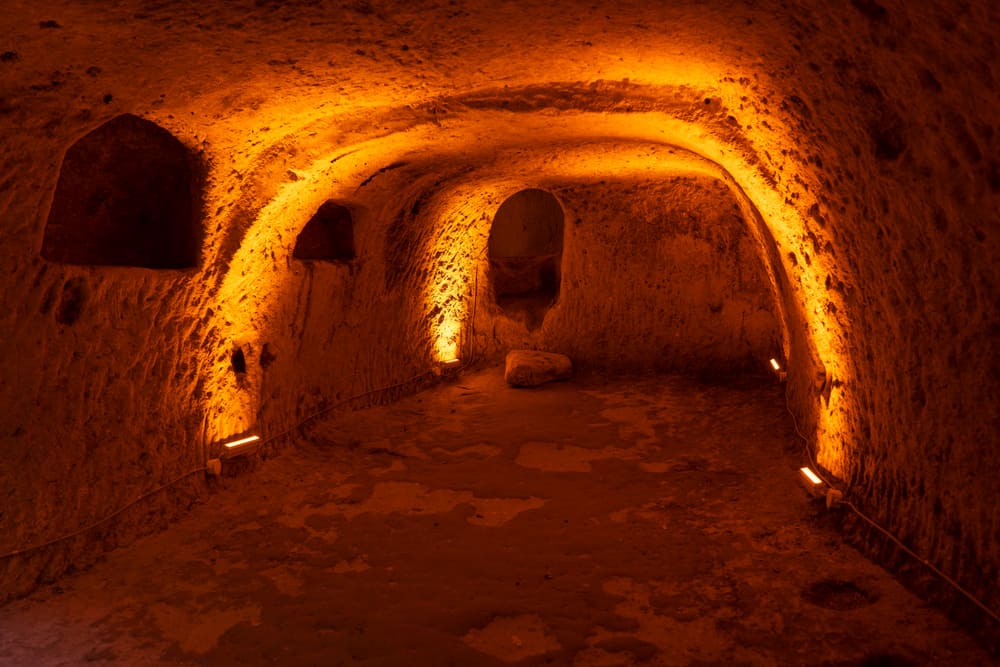
Kaymakli Underground City
What To See in Cappadocia; Kaymaklı Underground City is another point as popular as Derinkuyu among the underground cities of Cappadocia. The history of the underground city, located in Kaymaklı, 20 km from Nevşehir, dates back to 3000 BC, to the Hittite period. With the expansions in the Roman and Byzantine periods, it has turned into a city with 8 floors and 5,000 people. Only 4 floors of Kaymaklı Underground City can be visited. If you go down to the 4th floor, you will have descended 20 km deep into the ground.
